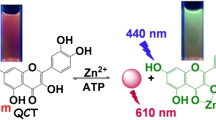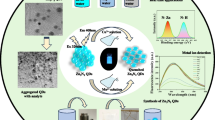Abstract
We report on a simple, sensitive and regenerable fluorescent nanoprobe for Zn(II) ion. It is based on the use of glutathione capped CdTe quantum dots (GSH-CdTe Q-dots). The bright fluorescence of these Q-dots is quenched on addition of diethylenetriaminepentaacetic acid (DTPA) due to the binding of DTPA to GSH. If, however, Zn(II) is added, it will bind DTPA and detach it from the surface of the Q-dots, this resulting in the fluorescence recovery. Under optimum conditions, the intensity of the restored fluorescence is proportional to the concentration of Zn(II) in the 0.48 to 90 μmol · L−1 range, with a limit of detection of 0.14 μmol · L−1. The nanoprobe was applied to the determination of Zn(II) in spiked tap water and river water and gave satisfactory results. The findings were also applied to design a molecular logic gate where DTPA acts as the first input to the system by quenching the fluorescence of the GSH-CdTe Q-dots. Zn(II) acts as the second input and causes the detachment of DTPA from the Q-dots and a restoration of fluorescence. This system therefore represents a new IMP (IMPLICATION) logic gate.

We describe a fluorescent nanoprobe for Zn(II) based on quantum dots, and its use in an IMP molecular logic gate. The nanoprobe was successfully applied to the determination of Zn(II) in spiked tap water and river water.









Similar content being viewed by others
References
Cuajungco MP, Lees GJ (1997) Zinc metabolism in the brain: relevance to human neurodegenerative disorders. Neurobiol Dis 4:137–169
Shankar AH, Prasad AS (1998) Zinc and immune function: the biological basis of altered resistance to infection. Am J Clin Nutr 68(suppl):447S–63S
Bush AI (2000) Metal and neuroscience. Curr Opin Chem Biol 4:184–191
Chasapis CT, Loutsidou AC, Spiliopoulou CA, Stefanidou ME (2012) Zinc and human health: an update. Arch Toxicol 86:521–534
Jurowski K, Szewczyk B, Nowak G, Piekoszewski W (2014) Biological consequences of zinc deficiency in the pathomechanisms of selected diseases. J Biol Inorg Chem 19:1069–1079
Bush AI (2003) The metallobiology of Alzheimer’s disease. Trends Neurosci 26:207–214
Voegelin A, Peister S, Scheinost AC, Marcus MA, Kretzschmar R (2005) Changes in zinc speciation in field soil after contamination with zinc oxide. Environ Sci Technol 39:6616–6623
Wilhartitz P, Dreer S, Krismer R, Bobleter O (1997) High performance ultra trace analysis in molybdenum and tungsten accomplished by on-line coupling of Ion chromatography with simultaneous ICP-AES. Microchim Acta 125:45–52
Kara D, Fisher A, Hill SJ (2005) Preconcentration and determination of trace elements with 2, 6-diacetylpyridine functionalized Amberlite XAD-4 by flow injection and atomic spectroscopy. Analyst 130:1518–1523
Li Q, Zhao XH, Lv QZ, Liu GG (2007) The determination of zinc in water by flame atomic absorption spectrometry after its separation and preconcentration by malachite green loaded microcrystalline triphenylmethane. Sep Purif Technol 55:76–81
Ciglenečki I, Bura-Nakić E, Inzelt G (2007) Voltammetry as an alternative tool for trace metal detection in peloid marine sediments. Electroanalysis 19:1437–1445
Srivastava SK, Gupta VK, Jain S (1996) PVC-based 2,2,2-cryptand sensor for zinc ions. Anal Chem 68:1272–1275
AL-Kindy SMZ, Al-Hinai KH, Suliman FEO, Al-Lawati HJ, Pillay A (2011) Development of a selective fluorimetric technique for rapid trace determination of zinc using 3-hydroxyflavone. Arab J Chem 4:147–152
Compano R, Ferrer R, Guiteras J, Prat MD (1996) Flow injection method for the fluorimetric determination of Zn with 8-(benzenesulphonamido) quinoline. Microchim Acta 124:73–79
Xu H, Miao R, Fang Z, Zhong XH (2011) Quantum dot-based “turn-on” fluorescent probe for detection of zinc and cadmium ions in aqueous media. Anal Chim Acta 687:82–88
Shang Y, Qi L, Wu FY (2012) Functionalized manganese-doped zinc sulfide quantum dot-based fluorescent probe for zinc ion. Microchim Acta 177:333–339
Pradhan N, Goorskey D, Goorskey J, Peng XG (2005) An alternative of CdSe nanocrystal emitters: pure and tunable impurity emissions in ZnSe nanocrystals. J Am Chem Soc 127:17586–17587
Murphy CJ (2002) Optical sensing with quantum dots. Anal Chem 74:520–526
Chen JL, Chen CQ (2005) Functionalized cadmium sulfide quantum dots as fluorescence probe for silver ion determination. Anal Chim Acta 546:147–153
Tang GC, Du LP, Su XG (2013) Detection of melamine based on the fluorescence resonance energy transfer between CdTe QDs and rhodamine B. Food Chem 141:4060–4065
Liu SY, Shi FP, Chen L, Su XG (2013) Bovine serum albumin coated CuInS2 quantum dots as a near-infrared fluorescence probe for 2,4,6-trinitrophenol detection. Talanta 116:870–875
Chen Z, Chen JY, Liang QW, Wu DD, Zeng Y, Jiang B (2014) ZnSe quantum dots basedfluorescence quenching method for determination of paeoniflorin. J Lumin 145:569–574
Huang S, Zhu FW, Xiao Q, Su W, Sheng JR, Huang CS, Hu BQ (2014) A CdTe/CdS/ZnS core/shell/shell QDs-based “OFF-ON” fluorescent biosensor for sensitive and specific determination of L-ascorbic acid. RSC Adv 4:46751–46761
Baker BA, Mahmoudabadi G, Milam VT (2013) Strand displacement in DNA-based materials systems. Soft Matter 9:11160–11172
Furukawa K, Minakawa N (2014) Allosteric control of a DNA-hydrolyzing deoxyribozyme with short oligonucleotides and its application in DNA logic gates. Org Biomol Chem 12:3344–3348
Uchiyama S, Kawai N, de Silva AP, Iwai K (2004) Fluorescent polymeric and logic gate with temperature and pH as inputs. J Am Chem Soc 126:3032–3033
Liu J, Lin Q, Zhang YM, Wei TB (2014) A reversible and highly selective fluorescent probe for monitoring Hg2+ and iodide in aqueous solution. Sensors Actuators B 196:619–623
Liu J, He XX, Zhang J, He T, Huang LQ, Shen JQ, Li D, Qiu HY, Yin SC (2015) A BODIPY derivative for colorimetric and fluorometric sensing of fluoride ion and its logic gates behavior. Sensors Actuators B 208:538–545
Wang LL, Li B, Zhang LM, Li P, Jiang H (2013) An optical anion chemosensor based on a europium complex and its molecular logic behavior. Dyes Pigments 97:26–31
Magri DC, de Silva AP (2010) From PASS 1 to YES to AND logic: building parallel processing into molecular logic gates by sequential addition of receptors. New J Chem 34:476–481
Liu YF, Yu JS (2009) Selective synthesis of CdTe and high luminescence CdTe/CdS quantum dots: the effect of ligands. J Colloid Interface Sci 333:690–698
Yu WW, Qu LH, Gao WZ, Peng XG (2003) Experimental determination of the extinction coefficient of CdTe, CdSe, and CdS nanocrystals. Chem Mater 15:2854–2860
Zhang TL, Sun XG, Liu B (2011) Synthesis of positively charged CdTe quantum dots and detection for uric acid. Spectrochim Acta Part A 79:1566–1572
Li L, Qian HF, Fang NH, Ren JC (2006) Significant enhancement of the quantum yield of CdTe nanocrystals synthesized in aqueous phase by controlling the pH and concentrations of precursor solutions. J Lumin 116:59–66
Lakowica JR (1999) Principles of fluorescence spectroscopy, 2nd edn. Plenum Press, New York, p 237
Liu Y, Loh WQ, Ananthanarayanan A, Yang C, Chen P, Xu CJ (2014) Fluorescence quenching between unbonded graphene quantum dots and gold nanoparticles upon simple mixing. RSC Adv 4:35673–35677
Hu YJ, Yang YO, Dai CM, Liu Y, Xiao XH (2010) Site-selective binding of human serum albumin by palmatine: spectroscopic approach. Biomacromolecules 11:106–112
Farahani BV, Bardajee GR, Rajabi FH, Hooshyar Z (2015) Study on the interaction of Co (III) DiAmsar with serum albumins: Spectroscopic and molecular docking methods. Spectrochim Acta Part A 135:410–416
Zhang XH, Zhai HX, Gao RQ, Zhang JL, Zhang Y, Zheng XF (2014) Study on the interaction between 4-thio-5-methyluridine and human serum albumin by spectroscopy and molecular modeling. Spectrochim Acta Part A 121:724–731
Habiby H, Afyuni M, Khoshgoftarmanesh AH, Schulin R (2014) Effect of preceding crops and their residues on availability of zinc in a calcareous Zn-deficient soil. Biol Fertil Soils 50:1061–1067
Acknowledgments
This work was supported by Chongqing Municipal Key Laboratory on Luminescence and Real-Time Analysis, Southwest University (CSTC, 2006CA8006).
Author information
Authors and Affiliations
Corresponding author
Electronic supplementary material
Below is the link to the electronic supplementary material.
ESM 1
(DOC 7834 kb)
Rights and permissions
About this article
Cite this article
Hao, C., Liu, S., Liang, W. et al. A regenerable fluorescent quantum dot based nanoprobe for zinc(II), and the design of a molecular logic gate. Microchim Acta 182, 2009–2017 (2015). https://doi.org/10.1007/s00604-015-1543-3
Received:
Accepted:
Published:
Issue Date:
DOI: https://doi.org/10.1007/s00604-015-1543-3




